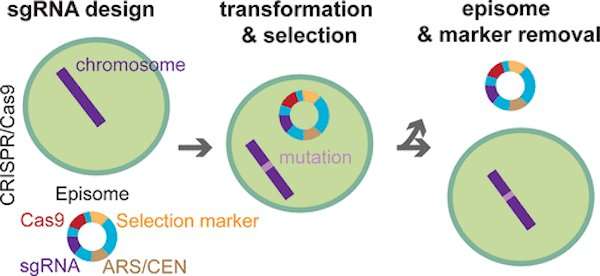A new DNA editing toolkit for the alga Nannochloropsis

Eric Poliner and a team of MSU scientists in the Farre and Benning labs have released a new genetic engineering toolkit for the alga Nannochloropsis. The alga is of interest for the production of biofuels and other oil-based chemicals.
Over the past decade, the science of engineering genes has become much more precise. That goes especially for CRISPR, a set of tools to delete or edit genes in an organism's DNA.
Scientists are using CRISPR to understand how plants and animals work. They are also exploiting it to create new applications in order to benefit humanity.
"Our new CRISPR toolkit targets Nannochloropsis, which is a great candidate for useful applications. This alga is quick to grow. It is easy to study. And it produces a lot of oil, which is interesting for industrial production," Eric says.
This genetic toolkit is a bit of a first, adds Eric. Although we have robust toolkits to manipulate microorganisms, like yeast or E. coli, those do not yet exist for algae.
'Hit and run' that changes algae's DNA
The heart of CRISPR is that it targets specific stretches of DNA for mutations. Scientists insert a gene construct – a package – in an organism. The construct includes a guiding mechanism to reach desired DNA areas and instructions to delete, expand, or change them.
"We insert mutations with the help of episomes, circular pieces of DNA foreign to Nannochloropsis. Our alga can maintain that foreign DNA for a while, which is unusual, as most other algae can't."

But as the algal cells multiply over the generations, a high percentage of the population loses the foreign DNA. They leave behind the precise mutation they brought to the genome.
"Using the episome approach is ideal for CRISPR. The mutation brought in with the construct survives in subsequent generations. It becomes an integral part of the genome," Eric says.
This feature would address public safety concerns in case engineered algae are ever mass-produced in open ponds. They might not be considered genetically modified organisms, due to the lack of foreign DNA.
In addition to the method to insert mutations, the toolkit includes tools to screen and introduce foreign genes. (See more below.)
"There are several university labs and biotech companies now working on this. The hope is that the toolkit will help the research community to expand," Eric adds. "My goal is to help researchers to do their advanced studies. I don't want them to reinvent the wheel, so the information is easily available to the community."
Technical Specifications
The latest study on the toolkit is published in ACS Synthetic Biology. The toolkit can be found on Addgene. Tools included:
- Cas9-reporter fusions: NanoLuciferase, GFP, and an HA tag;
- sgRNA produced with flanking self-cleaving ribozymes. A bidirectional promoter that drives coproduction of both components;
- Vectors containing the resistance markers for Blasticidin and Hygromycin;
- Vectors for overproducing multiple proteins simultaneously.
More information: Eric Poliner et al. Nontransgenic Marker-Free Gene Disruption by an Episomal CRISPR System in the Oleaginous Microalga, Nannochloropsis oceanica CCMP1779, ACS Synthetic Biology (2018). DOI: 10.1021/acssynbio.7b00362
Journal information: ACS Synthetic Biology
Provided by Michigan State University





















